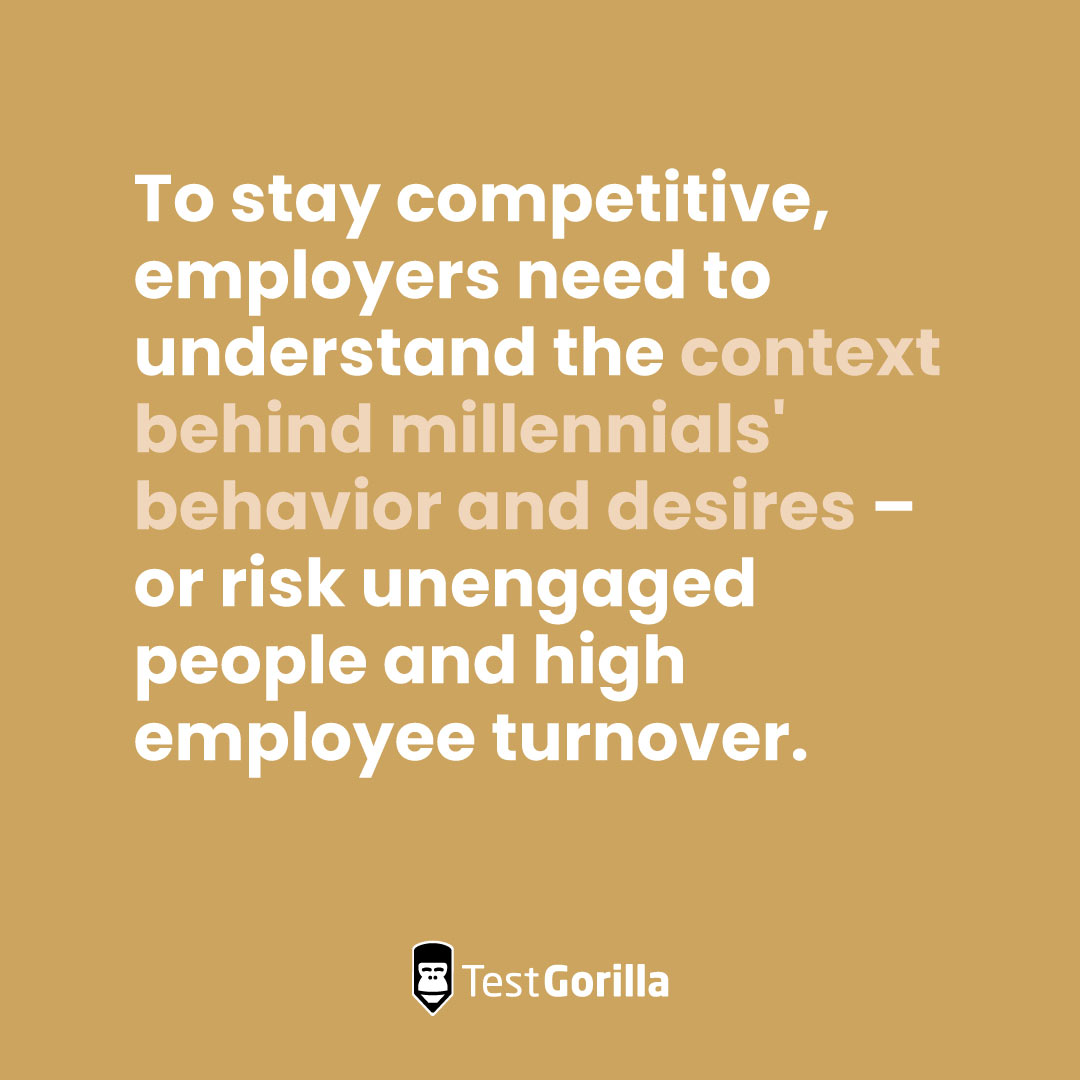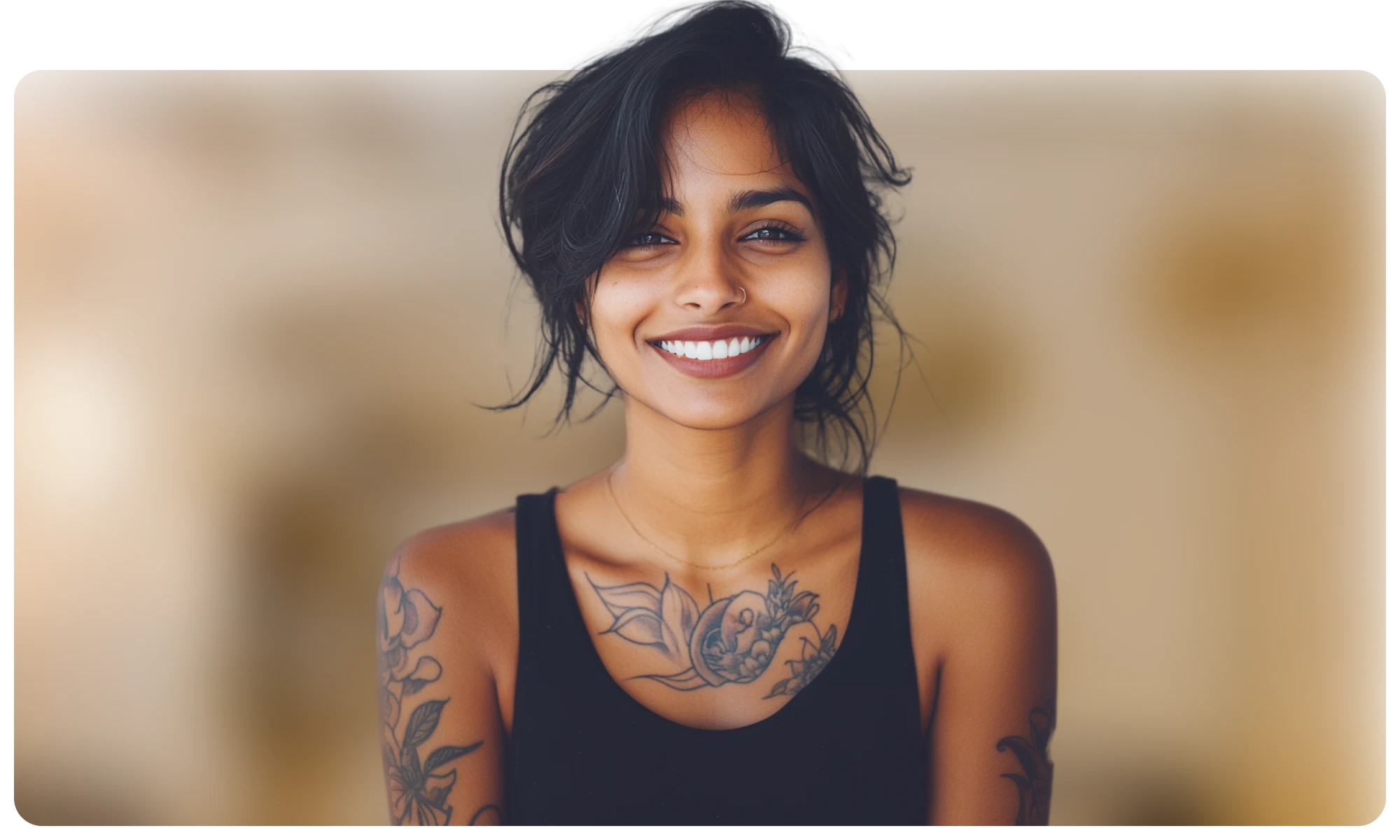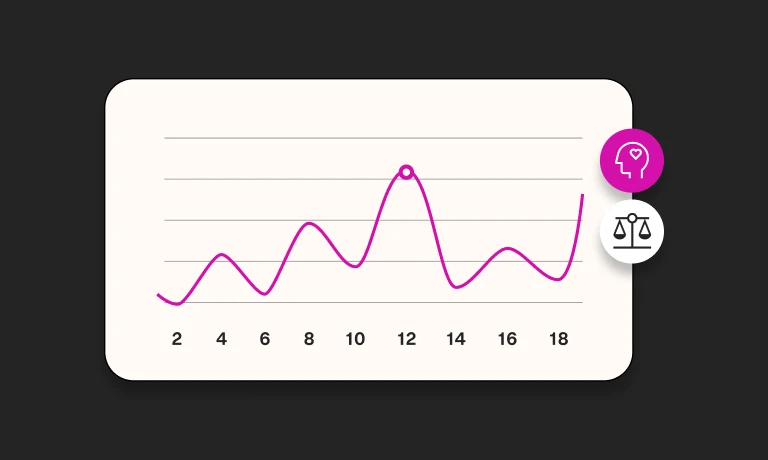No longer the youngest members of a team, millennials today make up the majority of the workforce and most of them say their job is central to their sense of identity.[1]
Despite this, they want a good work-life balance and most would switch jobs if they thought this would give them better career advancement opportunities or greater flexibility.
In this article, we take a close look at this highly educated (38% of millennials have degrees) and diverse (45% of American millennials are non-White) group of workers.[2] From the financial concerns that put them off making big life decisions like buying a house or starting a family to high levels of stress at work, we’ll look at how common worries impact their professional lives.
We’ll also list some best practices for how employers can get it right when recruiting millennials and how a skills-based approach to recruitment creates an equitable hiring process.
Understanding millennials
Born between 1981 and 1996, millennials have surpassed baby boomers in the workplace and will represent 75% of the workforce by 2025.[3] This means it's crucial to understand what makes them tick if you’re to win the war for skilled talent.
According to Brandon DiCroce, head of fintech engineering search at EC1 Partners: "As a generation, millennials have grown up in an era of rapid technological advancements and shifting social dynamics. Consequently, they tend to value work-life balance, personal growth, and a sense of purpose in their careers."
Millennials' desire for work-life balance ranks top of the list when it comes to choosing an employer. To attain this, they want more flexibility in where and when they work, which also helps explain the rise in hybrid and remote working post-pandemic.[1]
Moreover, their proficiency in digital skills and a purpose-driven mindset make them a compelling talent pool to hire from. However, their desire for meaningful work isn't always met by employers, and many millennials claim they'd like more flexibility and advancement opportunities at work.[1]
Let’s take a look at some challenges and misconceptions millennials face, and how employers can better attract, reward, and retain top talent.
Challenges and misconceptions
Employers can sometimes underestimate the value and potential of millennials because of common misconceptions. For example, one prevailing stereotype is that millennials have a sense of entitlement and are unwilling to work hard.
However, this perception disregards the fact that millennials have entered the workforce during challenging economic times and face unique economic pressures. In fact, 39% of millennials have a bachelor's degree or higher and often juggle multiple jobs to make ends meet.[3]
Another misconception is that millennials are job hoppers who lack loyalty and commitment to their employers. While it's true that millennials tend to change jobs more frequently than previous generations, this can be attributed to a variety of factors, including a desire for career growth, poor working conditions, and responding to a changing job market.
For example, millennials are often blamed for the Great Resignation, or voluntarily leaving their jobs during the pandemic. However, this behavior was a response to a time of great economic uncertainty which hampered their ability to plan for the future. This is also why they now seek growth and development opportunities and financial stability at work.
To stay competitive, employers need to understand the context behind millennials' behavior and desires – or risk unengaged people and high employee turnover.
The best insights on HR and recruitment, delivered to your inbox.
Biweekly updates. No spam. Unsubscribe any time.
7 best practices for hiring millennials
Thirty-nine percent of millennials feel anxious or stressed at work, while 82% claim mental health support is important when considering an employer.[1] This means it's important for employers to
understand how to motivate them. You also need to consider which work- and non-work-related factors could be playing a role in their stresses and mental health, for example, work-life balance, financial stability, climate change, etc. You can even measure a candidate's motivation to make sure they’ll feel motivated in your workplace.
By addressing the issues that matter most to your team, you can improve productivity and keep talented individuals of any age in the workforce.
Here are some best practices to help you design a recruitment program that gets you the best millennial talent.
1. Establish a stable working environment
According to Elizabeth Pharo, executive at Divorce.com: "Millennials want to be part of a community at work, and they want to feel like their contributions matter. As a hiring manager, it’s about fostering an environment that encourages collaboration and growth. Show them that their ideas are welcome and valued and that there are opportunities for them to develop and take on leadership roles."
This means it's vital to establish psychological safety in the workplace and create an environment where people feel fully supported to speak their minds. This is especially important considering 32% of millennials don't feel comfortable speaking to their manager about stress or other mental health challenges. [1]
To better attract millennial talent, you need to build a positive reputation around employee satisfaction and your company culture (more on this later). This starts with cultivating strong and supportive leadership and encouraging managers and supervisors to be approachable, empathetic, and responsive to employee needs. Good leaders provide guidance, support, and opportunities for growth and are rewarded with motivated, engaged employees who stick around longer.
2. Offer flexibility
According to Deloitte, 77% of millennials currently in remote or hybrid roles would consider looking for a new job if their employer asked them to work on-site full-time. Flexibility is key when it comes to recruiting millennials, and many of them want to see more part-time jobs overall. They also want the option to work more flexible hours for full-time employees. [1]
Fostering a flexible working environment also encourages your people to prioritize work-life balance while establishing mutual trust with the company. Remember: this is millennials' top consideration when looking for employment, so it can make all the difference.
"One unique approach is to offer personalized scheduling options that allow millennials to optimize their productivity and maintain healthy work-life integration. This could involve providing flexibility in core working hours or adopting a results-oriented approach that focuses on outcomes rather than micromanaging their time." Brandon DiCroce, head of fintech engineering search at EC1 Partners.
Here are some other ways you can increase flexibility for your team:
Remote or hybrid working arrangements
Childcare stipend
Healthcare package
Four-day work week
Flexible or async hours
Parental and sick leave
Unlimited paid vacation
By offering flexible hours, benefits, and working arrangements, you can improve employee satisfaction and attract people who are willing to work hard to achieve company goals.
3. Create a positive and inclusive company culture
Establishing a positive and inclusive culture can increase employee engagement and morale which leads to improving performance. This is because forming strong connections and a sense of belonging helps people find meaning in their work.
Since millennials are the most diverse generation yet, they also prioritize diversity and inclusion (D&I) in the workplace.[4] This means you could revamp your D&I strategy and make it known you're an employer that hires and rewards talent based on merit.
You can enhance your people’s commitment by building a diverse team and focusing on fairer hiring practices like assessing candidates on their skills, not their qualifications or experience.
Here are some other ways you can create an attractive company culture:
Lead by example. Leadership should embody the desired culture through their actions and decisions. Demonstrate inclusivity, fairness, and respect in all interactions, and hold everyone accountable to these standards.
Foster open, transparent communication. Create platforms for employees to share their ideas, concerns, and perspectives. Actively listen to feedback and take it into account when making decisions.
Create employee resource groups. Also known as affinity groups, these advocate for and support underrepresented minorities within the organization. They provide a platform for employees to connect, share experiences, and drive initiatives that promote inclusivity and understanding.
Training and education. Provide D&I training to employees at all levels. This can include workshops, seminars, or online modules that raise awareness about unconscious bias, cultural competence, and the importance of inclusivity.
Hire for culture add, not culture fit. When hiring for culture fit, you aim to bring in new team members who align with the existing values, behaviors, beliefs, and even sense of humor of your company. On the other hand, when seeking culture add, you actively invite individuals who can contribute a unique and fresh perspective to the team, bringing in new ideas and diverse viewpoints.
4. Use a skills-based approach to hiring and promotion
In our 2024 State of Skills-Based Hiring report, 82% of 25 to 34-year-olds expressed a preference for skills-based hiring processes. Why do younger generations prefer skills-based hiring?
The answer: Younger workers are less likely to have college degrees, want opportunities for continuous learning, and demand that employers prioritize workplace diversity.
When you use talent assessments to evaluate candidates on their skills, it's easier to remove unconscious bias from the recruiting and promotion process. These tests and assignments help you better align people with positions, which makes them happier in their roles and stay longer.
According to our 2022 State of Skills-Based Hiring report, 91% of employers also saw an increase in workplace diversity when using a skills-based approach to hiring.
You can also use talent assessments to help reskill and upskill employees. By tracking employee skills development, you can make decisions about internal promotion in a fairer, more measurable way. This also lets you build employee trust and engagement, because you're prioritizing and investing in their growth.
Here are some tests you can use during hiring and beyond:
5. Take a tech-forward approach to hiring
To access a tech-savvy generation, it's important to meet them where they are. This means using technology to scout and recruit your team.
Here's how:
Post online job ads. Use online job boards, professional networking platforms, and your company's website to advertise job openings. Craft compelling and detailed job descriptions that highlight the required skills and qualifications, and make it easy for candidates to apply online.
Have a presence on social media and digital platforms. Use social media platforms like LinkedIn, Twitter, and relevant industry forums to promote job openings and engage with potential candidates. Depending on your budget you can also use targeted ads and sponsored content to reach a broader audience.
Use online skills tests. Leverage skills assessment platforms to evaluate candidates' hard and soft skills. These assessments can include coding challenges, logic-based tests, or simulated work scenarios, providing valuable insights into candidates' proficiency.
Online interviews. After your skills assessment, you can conduct video interviews using platforms like Google Meet or Zoom. This lets you evaluate candidates remotely while assessing their motivation and passion for the role and company.
6. Create a referral program
Referral programs are great tools for speeding up your hiring process, saving you time and money looking for candidates that align with your company.
However, just because someone from your company refers someone they think would succeed in the job, it doesn't guarantee they're a suitable candidate. This means you still need to test candidates for skills regardless of how they heard about you.
Testing for skills helps create a fairer referral process that keeps current employees motivated and engaged and ensures a fair hiring process for all applicants. If not managed carefully, referrals can add to existing imbalances in diversity across your teams, so prioritizing skills-based testing can help combat this.
Other ways to create a strong referral program include:
Developing program guidelines. Define the types of positions eligible for referral, any specific qualifications or experience required, and any limitations or exclusions. Outline the process for submitting referrals and specify the channels employees should use.
Providing resources and support. Offer access to job descriptions, employee testimonials, or marketing materials that employees can share with potential candidates. Provide guidance on how to make compelling referrals and answer any questions employees may have.
Prioritizing D&I. Ensure your processes and programs are accessible to anyone regardless of their backgrounds or privileges.
7. Establish a clear career path
Millennials are more concerned about job satisfaction and stability than a paycheck.[5] This means you need to show candidates what their career path might look like to encourage skills development and engagement – and long-term retention.
"By investing in their growth and skill enhancement, organizations demonstrate a commitment to their long-term success and provide millennials with a platform to advance their careers." Brandon DiCroce, head of fintech engineering search at EC1 Partners.
Here's how:
Goal setting and development plans. Encourage employees to set specific career goals and create plans to achieve them. Help them identify the skills, knowledge, and experiences needed for their desired career path. Collaborate on setting realistic and measurable milestones to track progress.
Skills assessment and training. Conduct skills assessments to identify employees' strengths and areas for improvement. Provide training opportunities, workshops, or online courses that align with their career goals and support their professional development.
Mentoring and coaching. Pair employees with experienced mentors or coaches who can provide guidance and support in their career journey. Mentors can share insights, provide advice, and help employees navigate challenges and opportunities. Coaching sessions could focus on the development of specific skill sets or address career-related concerns.
Skills-based hiring: Get more millennials through your door
As more baby boomers retire, millennials are playing an increasingly important role in the workforce. This makes it crucial to build a strategy to attract, hire, and retain millennial employees to win the battle for talent.
Tactics include offering flexibility in hours and working location, creating a positive and inclusive company culture, and taking a tech-forward approach to hiring to meet people where they live: online.
Adopting a skills-based approach to hiring millennial talent can also yield numerous benefits for organizations. This generation values meaningful work, career growth, and diverse and equitable working environments.
The bottom line is this: by focusing on skills rather than qualifications or experience, you can tap into a diverse pool of talented millennials. This group often possesses important transferable skills and a wealth of varied professional experiences.
Skills-based hiring also lets you find talented people who haven't followed traditional education pathways, like a four-year degree. This fosters inclusivity and innovation and helps organizations adapt their workforces to a rapidly changing business landscape.
Embracing a skills-based approach to hiring empowers millennials, opens up a wider talent pool, and positions organizations for long-term success in identifying and recruiting the best millennial talent. Employers can ensure they’re giving everyone an opportunity – even the in-betweeners. What’s not to love?
Want to hire the best talent from any generation? Skills-based hiring lets you access a wider, more diverse talent pool – so you can find the best candidates for every role. Download the State of Skills-Based Hiring 2022 report to learn more. |
Sources
"2023 Gen Z and Millennial Survey." (2023). Deloitte. Retrieved July 14, 2023. https://www.deloitte.com/global/en/issues/work/content/genzmillennialsurvey.html
"A Millennial Puzzle: More Diverse but More Segregated." (2023). The Wall Street Journal. Retrieved July 14, 2023. https://www.wsj.com/articles/a-millennial-puzzle-more-diverse-but-more-segregated-f8db5ae2
"Millennials in the Workplace Statistics: Generational Disparities in 2023." (2023). TeamStage. Retrieved July 14, 2023. https://teamstage.io/millennials-in-the-workplace-statistics/
"Millennial generation is bigger, more diverse than boomers." (n.d). CNN. Retrieved July 14, 2023. https://money.cnn.com/interactive/economy/diversity-millennials-boomers/
"What Millennials Want Is Good for Your Business." (2019). Gallup. Retrieved July 14, 2023. https://www.gallup.com/workplace/248009/millennials-good-business.aspx
Related posts
You've scrolled this far
Why not try TestGorilla for free, and see what happens when you put skills first.

















